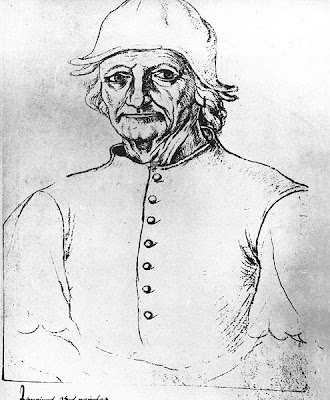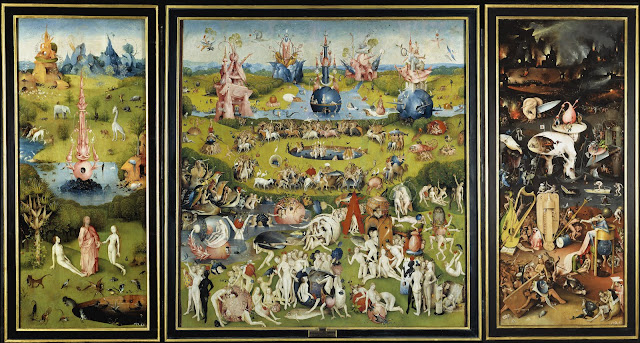Hieronymus Bosch
The first Surrealist?
Self-Portrait
"The master of the monstrous...the discoverer of the unconscious."
~ Carl Jung
Bosh is best known for his tryptichs, depicting fantastic imagery to illustrate the religious and moral preoccupations of his time.
"The master of the monstrous...the discoverer of the unconscious."
~ Carl Jung
Bosh is best known for his tryptichs, depicting fantastic imagery to illustrate the religious and moral preoccupations of his time.
Perhaps his most famous tryptich is The Garden Earthly Delights. I'll show you the whole piece, followed by several of my favorite details from the panels. The details contained within these three panels are amazing to behold, whether you're a fan of Bosh's style and subject matter, or not.
The Garden of Earthly Delights
1503-1504
Left Wing Details
Center Panel Details
Left Panel Details
Images courtesy of


-(detail-1)-c.-1500-large.jpg)
-(detail-3)-c.-1500.jpg)
-(detail-2)-c.-1500.jpg)




-c.-1500-large.jpg)

-c.-1500-large.jpg)
-(detail-1)-c.-1500.jpg)
-(detail-2)-c.-1500-large.jpg)

-(detail-7)-c.-1500-large.jpg)
-(detail-8)-c.-1500-large.jpg)















I don't like his work, so I don't want to include him with the surrealists who are some of my favorite artists. However, a more objective approach would put him there or close to being one.
ReplyDeleteI'm guessing you don't like the moral/religious message of his work. Otherwise, I can't imagine how anyone who likes surrealism, can't appreciate Bosh, at least in terms of imagination and painting ability.
ReplyDeleteThe only one I can remember having seen in reality was 'Ship of Fools' and although I love his work it's not exactly what you might want to hang over your couch. Absolutely his paintings could be described as surreal but whether he'd be accepted as a surrealist is a matter of better informed opinion than I could give. Considering his work was produced at the end of the Dark Ages and under an intensely autocratic and punitive Roman Catholic orthodoxy it's possible Bosch didn't have to stray too far from the realities he witnessed. Then again, his imagination was such that he was able to incorporate the nightmares of his age into visual form.
ReplyDeleteSusan: No, Bosch's work is definitely not decorative! :-D Although the posters are available on allposters.com, I've never seen one hanging on anyone's wall. At least that I recall.
ReplyDeleteThere is a lot of controversy in the art history world about whether Bosch's work should even be compared to the surrealists, who came along hundreds of years later. Maybe, maybe not. And I feel as you do - I don't know enough about it to take a strong stand. Still, it's a fun question to ask. The art world takes itself too seriously. Critics, historians, collectors and patrons seem to take it more seriously than the artists themselves.
To me, the work of Bosch has a surreaslistic "feel" to it and I love the detail. It's sort of I Spy for adults!
I guess I think art should be fun.
I absolutely love this work. I can't believe it is from the 16th century! It rivals R. Crumb, Gilbert Shelton and S. Clay Wilson. (that's what I'm relating it to as a novice art appreciation student).
ReplyDeleteThanks. A good find and post.
Peace.
Hi, Joe. I'm so glad you can share equally in my enthusiasm for Bosch! That makes all the work I put into this post completely worthwhile! Thank you, my friend.
ReplyDeleteR. Crumb I know but Shelton and Wilson, I'll have to look up. Thanks for the heads-up on them.
Peace to you, too.
really truly cool!!!
ReplyDeleteThanks, Sherry! :-)
ReplyDeleteThat guy was eating moldy bread.
ReplyDeleteBut seriously, what amazing technique, and composition, and vision. if he didn't precede and inform Dali, nobody did.
Exquisite post, M'Dear.
Pagan Sphinx: I think I realize what I don't like about Bosch, and I would guess it is a major reason why some people don't include him with the surrealists. What I find most compelling about the surrealists is their exploration of what the subconscious feels like, either as dreams, dreamlike imagery, or as the automatic products of our minds when we don't focus on them.
ReplyDeleteCunning: Bosch may have informed Dali's painting techniques, but he didn't inform Dali's artistic goals and what he was trying to communicate.
Bosch had the juxtapositions of surrealists, but he didn't use them for the artistic and emotional processes that I find so amazing. It feels like empty surrealism for me.
I think that we are fascinated by different aspects of surrealistic art. The different interpretations and reactions are fascinating themselves.
Your post is really making me think about the surrealists in ways I hadn't focused on before.
CR: moldy bread...hahahha...or maybe magic mushrooms
ReplyDeleteLib: thanks for clarifying your last comment a bit. Dali was painting during Freud's time. The nightmares and dreams of that era were understood in a very different way than during the middle-ages.
Both Dali and Bosch were driven to create from within their minds; they just lived at vastly different times. I guess that how I feel they are somewhat related.
I'm not dead-set on proving Bosch was a surrealist, or anything! :-)
Thanks for stopping by again, Libhom.
Pagan: I really don't know whether Bosch should be considered a surrealist for sure. But, your post really helped clarify what interests me about one of my favorite art movements. Thanks.
ReplyDeleteLibhom: I'm glad! I do have a "thing" for Bosch - that doesn't mean I'm right about anything I say about him!
ReplyDeleteIt's good that you can come here and derive some benefit from what I post. I know I do when I visit your blog, which is completely different from mine but keeps me up-to-date and thinking about issues that are important to me. Thank YOU! :-)